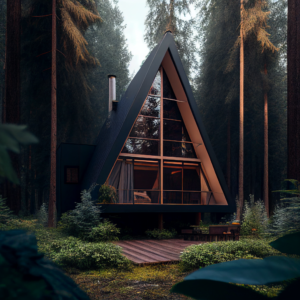Tiny House Movement: Historical Perspective
Tiny houses are a growing trend in the world of housing, with more and more people choosing to downsize and simplify their lives. But where did the tiny house movement come from? And why is it becoming increasingly popular? In this essay, we’ll take a look at the history of the tiny house movement, and explore some of the reasons why people are choosing to live in small homes.
The tiny house movement can be traced back to the early 2000s, when a man named Jay Shafer built a small, mobile home on a trailer bed. He founded a company called Tumbleweed Tiny House Company and began building and selling small homes. At the time, the idea of living in a tiny house was a novelty, but Shafer’s designs caught the attention of many people who were looking for an alternative to traditional, larger homes.

Victor Jung Tiny House Designs
Tiny House Solution for Affordable Housing
One of the main reasons for the rise of the tiny house movement is the increasing cost of housing. In many parts of the United States, the cost of buying or renting a home has become unaffordable for many people. Tiny houses, on the other hand, can cost a fraction of the price of a traditional home, making them a more affordable option for many. Additionally, many people are choosing to live in tiny houses because they want to reduce their environmental footprint and live a more sustainable lifestyle. Tiny houses are typically smaller, more energy-efficient and can be built using eco-friendly materials.
Tiny House Design Trends
Another reason for the popularity of tiny houses is the desire for a simpler and more minimalist lifestyle. Many people are choosing to downsize their possessions and focus on what truly matters in life. Tiny houses provide a unique opportunity to live with less and focus on what’s important. Furthermore, tiny houses are often mobile and can be placed in a variety of locations, this gives people the opportunity to live in different areas, and experience different parts of the country or even the world.

Victor Jung Tiny House Designs
However, the tiny house movement is not without its challenges. One of the main challenges is zoning and building codes. Many municipalities have zoning laws and building codes that make it difficult to build or place tiny houses. Additionally, tiny houses are not considered as a permanent residence in most places, so it’s difficult for people to find a place to live long-term. As a result, many tiny house dwellers have to move around frequently, which can be difficult and disruptive.
Despite these challenges, the tiny house movement is continuing to grow in popularity. Many people are choosing to live in tiny houses because they want a more affordable, sustainable, and minimalist lifestyle. Furthermore, the tiny house movement is challenging traditional ideas about what a home should look like, and it’s encouraging people to think differently about what they need to live a happy and fulfilling life.
California ADU Tiny House Update July 2022
California is turning out to the the pioneer in ADU (Accessory Dwelling Unit) / Tiny house movement in the United States. Attached is the most recent California ADY Udpdate published in July 2022. The builders in Latvia, Scandinavia, and Australia seem to be trailblazers in tiny house design and implementation as housing stock.

Victor Jung Tiny House Designs
Tiny House Movement
In conclusion, the tiny house movement has come a long way since it began in the early 2000s. Today, it’s a growing trend that’s changing the way we think about housing and home ownership. With its focus on affordability, sustainability, and minimalism, the tiny house movement is providing an alternative to traditional, larger homes. While there are still challenges to overcome, such as zoning and building codes, the tiny house movement is here to stay and it’s an option that should be considered by those who want a simpler and more sustainable lifestyle.
Are you in the market for a tiny house? Contact Victor Jung and his at V Global Holdings for your free consultation.

